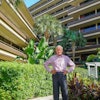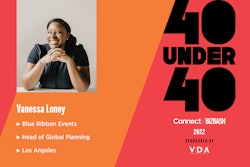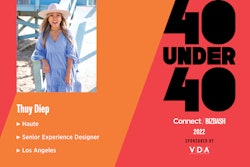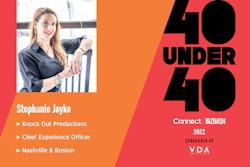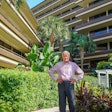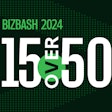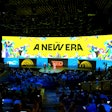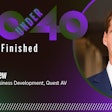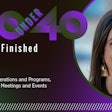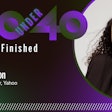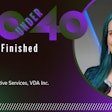
Trey Weaver, CMP, CFMP, CTA, is the 38-year-old meetings manager for the American Academy of Forensic Sciences. He's based in Colorado Springs, Colo.
What I do:
I half-joke (as many of us do) that I herd cats in a room filled with laser pointers, catnip and the sound of tuna cans opening in every corner. I endeavor to create environments where people are able to engage with one another and with the things they are passionate about, so when they leave the venue (or disconnect from the Zoom), they are energized, encouraged and excited about the work they do or the community of which they are a part. My goal is to make everything about the experience, connections and education for the attendees, which in turn allows them to grow and improve in their own work and communities.
Why I love my job:
I always say this is my opportunity to impact the world, whether in large or small ways. By bringing people together, connecting them with their passions and with others who share in those passions, I can be a part of the ripple effects that lead to greater impacts in science, progress in society or maybe just two people becoming lifelong friends. It’s how I make my own contributions to our world.
My career journey:
I was one of the thousands impacted by COVID layoffs, finding my current role after nearly a year unemployed (though I know I’m fortunate in that, as so many others had it a lot worse). I’ve been in the industry for nearly 20 years in various sectors, with a particular focus on nonprofits and associations focused on mission-driven goals such as community building, education and equality.
My greatest career accomplishment:
While I was working with the Tennessee Department of Education, we were given a federal grant to overhaul educational standards statewide. We had no roadmap for this other than the content we wanted to get to as many teachers/schools as possible. So we developed, from the ground up, a 24-month program that allowed us to train over 47,000 educators through a series of over 300 events statewide.
Most of this took place over the summer breaks, where we ran 127 concurrent training sites throughout the state, each with operating overlapping weeklong programs for educators. We had to ensure that the learning environment for these educators allowed them to fully engage in what they needed to transfer into the classroom; it was more than just sitting them in a room, it was creating a rewarding and foundational experience for this work.
It was one of the best logistical puzzles I’ve ever worked on, and the impact was so rewarding to see definitive improvement in how our students learned. (Also, if you’ve never had to purchase 20,000 packs of Post-it notes, it’s quite a surreal experience.)
How I helped my organization during COVID:
Like so many in our industry, I was unemployed during COVID because of budget-related cutbacks at my previous company; however, during that time I still worked to help support a number of nonprofits with which I am connected in continuing to offer opportunities and experiences to bring their communities together. Many of these didn’t have the resources to hire out big production companies for virtual experiences, so I reached out through my own networks to find volunteers and resources that could offer these opportunities without emptying their cash reserves.
The time I averted a complete event disaster:
I was working on a civic education program in Washington, D.C., organized around President Obama’s first inauguration. On opening day, I was on-site at the University of Maryland, College Park, where 8,000 middle school students were set to arrive for the opening sessions after they had first been able to check into their hotels to drop off luggage and get an initial orientation for how the week would work. Unfortunately, due to flight delays and traffic issues, conference leadership started directing the buses directly to the program site, where the students were arriving with their luggage, and without instructions on what to do next. I was part of a team of eight running operations for the event site (who took over from the planning team), so we quickly had to start looking at contingencies for handling luggage and getting key information communicated to students and program staff.
The real challenge came at the end of the program when a confluence of events created absolute chaos for these 8,000 students. We had over 125 charter buses on site that would transport the students to one of 47 hotels we were working with in the D.C. metro area. However, because of the disruption in how the buses were supposed to be operating, when it came time for the conclusion of the opening session and dismissal back to the buses, the buses had not staged properly in the order in which they were supposed to be, and many of the students didn’t know which bus designation to look for in order to transport to the correct hotel. We knew we needed to figure out a solution that was able to keep the kids safe, parents happy and the buses moving before drivers started hitting mandatory off-time.
We pulled the operations team together with the charter company coordinator and the staff leadership responsible for the student groups. We were able to adjust the transportation plans to allow a group of buses to drop off at multiple hotel sites within a local area, which in turn allowed us to get students onto these buses more quickly. We then stationed someone on radio in a central area while the rest of us spread out to make a quick map of bus locations. Once we had that, we moved students onto buses as quickly as possible, and rolled them out as they filled up. We took what could’ve been a three- to four-hour ordeal and were able to get all students rolling off-site within 90 minutes. We then relooked at the entire transportation plan for that program site to better ensure minimal issues during the remainder of the week.
My most memorable event experience in the past year:
We recently completed our first return to an in-person conference for my current organization, and it was so immensely rewarding to see how happy our attendees were to be back face-to-face again.
Similarly, this same program had been consistently losing exhibitors year-to-year due to feeling the environment hostile to vendors and uncompromising for any of their requests or concerns. One of my chief priorities this year taking over the program was to start mending those relationships, regaining trust and rebuilding the program. While on-site, we had a meeting with exhibitor representatives and organizational leadership (including executive direct, board chair and board chair-elect), where all of the attending exhibitors were beyond ecstatic in the change of communication, respect and understanding of how exhibitors play an integral part of the conference experience. It was absolutely wonderful to hear their feedback like that.
Best advice I’ve ever received:
Understanding the partnership between planners and suppliers will go much farther than always seeing it as an "us versus them" situation. Sometimes it’s not always possible, but nine times out of 10, if you and your site/vendor/supplier are focused on working together for the benefit of both, it will help ensure the best experience for your constituents.
Impressive stats I’m responsible for:
TN Department of Education: Built and deployed logistics from conceptualization to fruition for a state-wide training initiative involving 127 concurrent multisite, multiday trainings, impacting over 47,000 education professionals over a 24-month period.
Gay Christian Network: Took program ownership of the four-day annual conference first as a volunteer, then as a staff member, improving attendance from 325 to 1,400-plus people over nine years. Also, revamped the volunteer program from 10 volunteers to a sustained 300-plus person team, year-over-year.
Cardinal Health: Within weeks of being hired, I was tasked with a ground-up implementation of a new, immensely complex registration process for their annual flagship customer conference of over 8,000 attendees. The process involved competing requirements from multiple stakeholders, some of which required custom-built integration and/or process pieces to achieve the necessary data collection and synchronization. All of which had to be completed within six weeks of my start at the company.
What’s next?
We just wrapped up our major annual event, so a lot of what’s to come will be reviewing how the hybrid model worked (and ways it maybe didn’t) while taking this opportunity to look for overall areas of improvement and progress. (My entire team is new to this organization, so having now seen the nuances and complications of this particular event, we’re better prepared to make such suggestions.) In addition, we’re looking to expand the educational offerings of the program throughout the year, something that hasn’t before been done with this organization.
What I do outside of work:
Outside of my role with AAFS, I sit on a couple of nonprofit boards focused on LGBTQ+ work, including the LGBT Meeting Professionals Association (an industry-focused organization representing LGBTQ professionals and communities), and the Equality Federation (a national organization that supports state-run LGBTQ and social justice initiatives through training, legislation tracking and resource support).
I’m also the co-founder of OutChristian, an LGBTQ faith-based organization that looks to build community and foster interpersonal connection among LGBTQ Christians and allies, a group that has long been told that these two elements of their lives aren’t able to co-exist. (Spoiler: They can.)
And when I’m not busy with all of that, I like to travel and check out great restaurants.
Dream vacation:
My vacation bucket list is immense, but at the top of it: I’d love to do a three-week tour throughout England, Scotland, Ireland, North Ireland and Wales. (This would, of course, include a stop at Highclere Castle, filming location of Downton Abbey, a not-at-all guilty pleasure of mine.) I’d especially love to visit some of the scotch distilleries of Scotland.
Favorite icebreaker line:
Pets! People are never as happy to randomly start talking about something as when the subject of our furry (or scaley) friends comes up.
Connect with Weaver on LinkedIn.
“Connect x BizBash 40 Under 40” is sponsored by VDA, an experiential marketing and event design agency based in Massachusetts that specializes in custom live, virtual and hybrid experiences.


